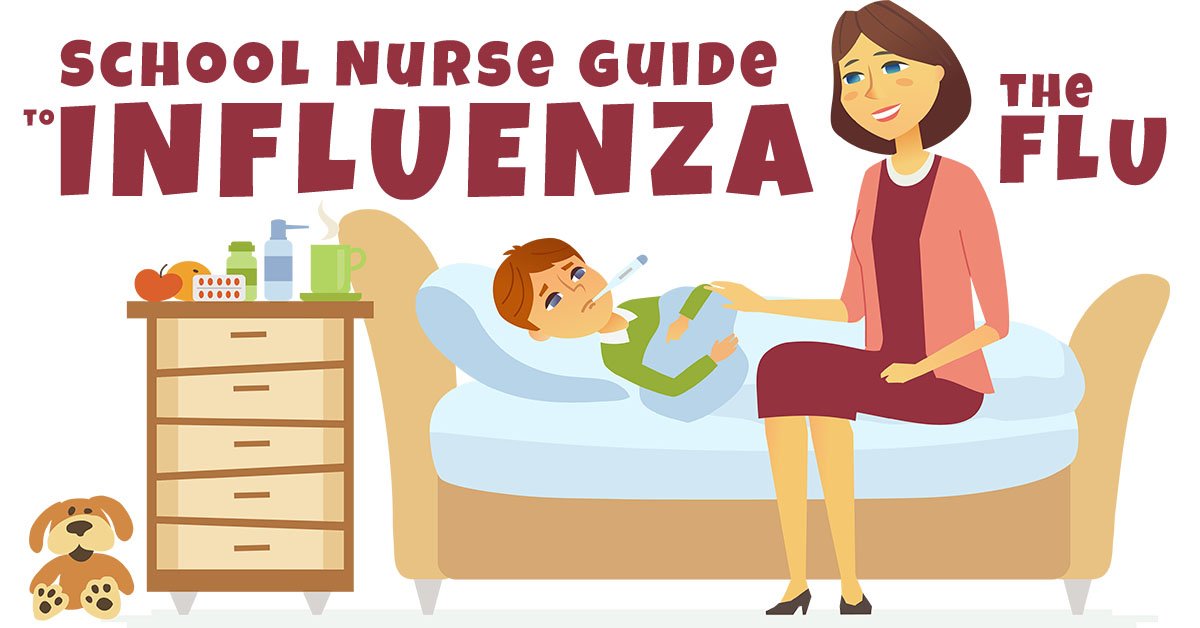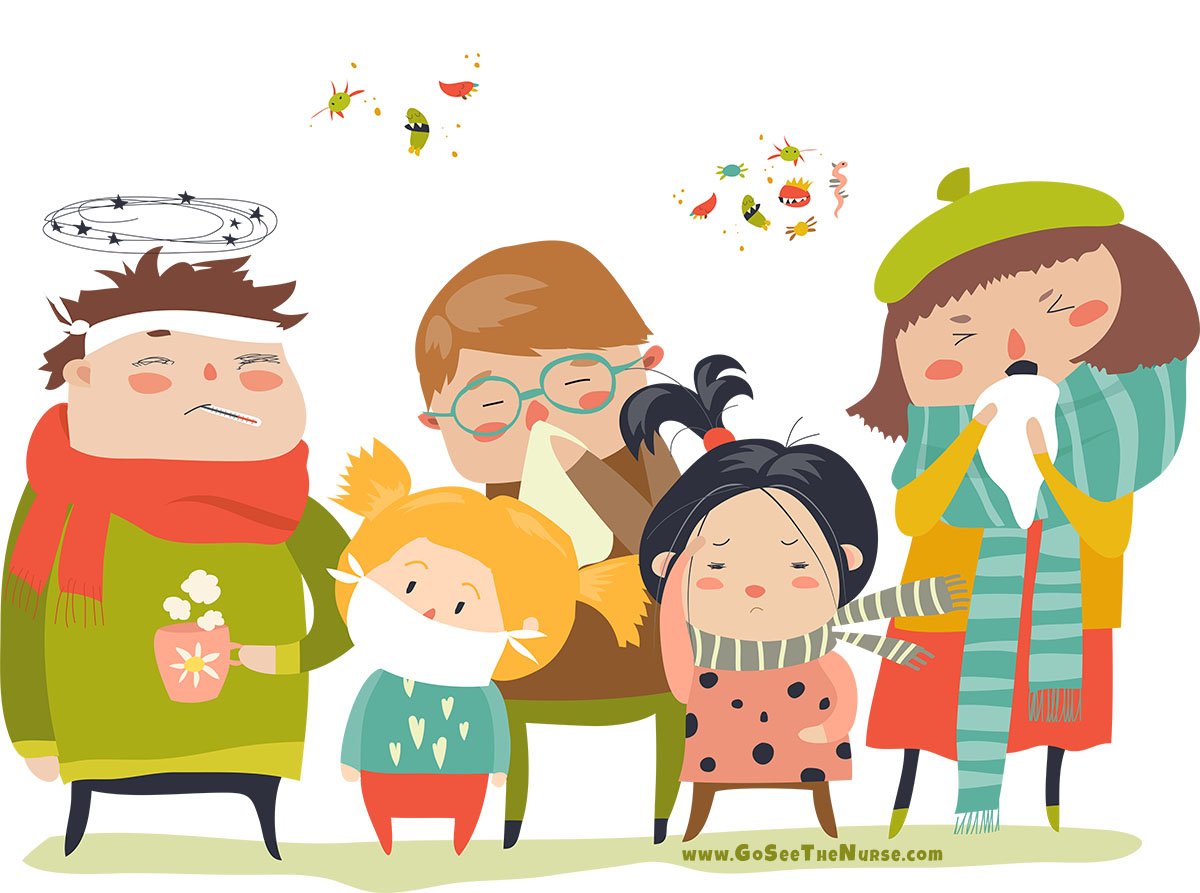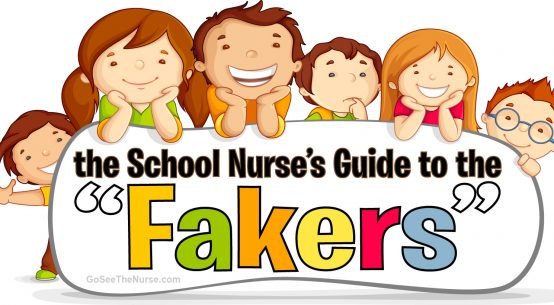
We all love free stuff. However, there should be an asterisk by the word “stuff.” It should look something like this: “We all love free stuff*.” The “*” clarification should be, “Unless it’s chewed bubble gum, unpopped popcorn kernels, or the flu.” Needless to say, there are many, many, MANY folks who will receive their very own FREE version of the flu this season.
A mother calls the office, “My kid is staying home today because he has the ‘bird flu’.” Some mammas want to make sure their “situation” is appreciated. We all want our situation appreciated, right? As school nurses, though, as soon as word gets around that someone has contracted the “bird flu,” the threshold of your office fills with concerned teachers and faculty members who want to know, “Are we safe to be here? What should we watch for?”
In this article we’ll discuss:
- What is the flu (influenza)?
- What is the contagious period?
- What are the symptoms of the flu?
- How does the flu spread?
- How to control the flu in your school house
- To exclude or not to exclude
- Other stuff (or should I say, “stuff*”)
What is the flu (influenza)?
The flu is caused by a virus, not a bacteria. We nurses know that, but for the many, many patients I have had over the years who have asked for antibiotics “because I have the flu,” I just wanted to cover that. The flu (influenza) is a contagious viral infection that attacks folks’ respiratory system.
There are four types of influenza: A, B, C, and D. We humans have to worry about becoming sick from Influenza A, B, and C. Influenza D does not make humans ill (yet). Influenza D will make cows sick, but has not yet “emerged” to cause illness in humans (that we know of).
Influenza A
When someone calls and reports “bird flu,” and we’ve been teaching and working with this individual for the past few days, a tiny bit (more in some than others) of panic starts in, and their questions find their way to the school nurse.
Birds, just like you and I, can get the flu. Birds, like chickens and ducks and geese (oh my!) can get the flu and pass it along only to other birds…in most cases. However, bird flu (avian influenza) like H5N1, is super-dangerous. It’ll kill most birds…and, since the first human case in 1997, this strain of influenza has killed most folks who have contracted it (60% who get the H5N1 virus die from it).
Back in 2009, the H1N1 virus emerged and cause the first global pandemic in more than 40 years. There were a bunch of really sick folks that required hospitalization…some did not make it (actually, many did not make it).
What does that “H” and that “N” mean?
There are two sub-types of Influenza A. There are two proteins on the surface of the viruses. They are called hemagglutinin (H) and neuraminidase (N). They differentiate even more into tinier subsets: “18 different hemagglutinin subtypes and 11 different neuraminidase subtypes. (H1 through H18 and N1 through N11, respectively).” Influenza A has been the culprit behind all of the major flu pandemics, and the type A flu virus is constantly changing. From the Spanish flu of 1918 to the 2009 pandemic…one or another of the Influenza A strains have been the “evil-doer.”
When folks hear the key words “Influenza A,” “bird flu,” and “swine flu,” they get a little panicked…and they should…folks die from Influenza A. When folks are concerned in your school house, they will come to you for information…and information will empower…empowered people are more comfortable people…these people will start washing their hands more and “stop touching their face.”
“Don’t want to get sick? Don’t touch your face.” – Nurse Kevin
What is the contagious period?
Once you are destined to become sick, it’ll take about one to four days to start showing symptoms (incubation period). I say, “destined to become sick”; we may have come into contact with the virus, and the virus may very well have made contact with our mucus membranes, but our own strong immune system nipped it in the bud, before the virus could make us sick.
A person is considered contagious the day BEFORE symptoms are noted. Consider the person contagious for a minimum of SEVEN days AFTER the onset of flu symptoms. But, as great school nurses, we more than welcome parents to keep their children home for a bit longer. Shedding of the virus could last for longer than seven days in some folks. (Managing Infectious Diseases in Child Care and Schools: A Quick Reference Guide (American Academy of Pediatrics)
What are the symptoms of the flu?
Symptoms of the flu may include (some or all):
Sudden onset of a fever and even a high fever (102 degrees F or greater [but not everyone with the flu develops a fever])
Runny or stuffy nose – congestion
Pinkeye-like symptoms
Sneezing
Coughing
Sore throat
Fatigue
Body aches – muscle aches and pains
Chills
Croup, bronchiolitis (inflammation of the bronchioles) or pneumonia
Headache, especially around and behind the eyes
Loss of smell, may last a few days or weeks
Nausea, vomiting, and diarrhea (more common in children)
On the flip side, the most common cold presents with:
Runny or stuffy nose
Sneezing
Post-nasal drip
Coughing
Sore throat
Watery eyes
Fatigue
Body aches
Mild headache
Low-grade fever (more likely in children)
There are those folks that are there on Monday, absent on Tuesday, and back on Wednesday, saying, “I had the flu.” It’s not too likely. Possible. Not likely. The flu will knock you down a step or two for sure. Influenza C produces less of a “butt-whoopin’” than does Influenza A or B. But, more than likely, a short-lived “illness” was probably not the flu. And, that assumption that they “had the flu” tends to reduce the emotional significance of the actual flu. Usually, when you get sick with the flu, you are down for the count!
NOTE: Pay special attention to any bowel incontinence. It may just be a kinder with a poopy butt who had a G&L episode, or he may be a kinder with diarrhea who is a developing case of the flu. By the way, are you asking, “What’s a G&L episode?” Check the bottom of this article.
How does the flu spread?
The flu is spread via the droplet route. Someone with the flu and in the contagious period may talk to you or sneeze or cough in your general direction or on a surface you end up touching. The infected person may wipe their nose or cough into their hand and touch a surface you subsequently touch. When you “touch your face” (any mucus membrane), you end up putting their virus into your body. Basically, you get the flu virus in your body by getting someone else’s mucous membrane secretions onto your mucus membranes. To be more simplistic: When their slobber and snot mixes with your slobber or snot.

How to control the flu in your school house?
Prevention is the key. Heck, prevention is the key to avoiding most anything. It’s like money: most folks run around with their brand-new shiny credit cards buying hundred-dollar hats for their nickel heads and wondering why they ain’t got no money at the end of the month. Preventing the debt is the best plan.
The flu vaccine is the best defense from the inevitable influenza offensive. You will be exposed to the flu at some point during the flu season (in the northern hemisphere, the flu season is considered October through May [peaks in February]). In the southern hemisphere, the flu season is considered May through October (peaks in August). Here in Idaho, we had our flu clinic for the staff in early October and for the kids, as well (yep…an in-school vaccine clinic).
Aside from the vaccine, good, ol’ fashion handwashing with soap and water is a biggie…THE BIGGIE! Handwashing has been and will continue to be the #1 way to keep from getting the flu, forever and ever in a world without end. And…remember…“don’t touch your face.”
Vaccines, handwashing, and keeping surfaces (like door handles) clean is something WE can do for ourselves. We can also be the flu police and “call folks to the plate”! What I mean is, teach and insist that sneezers and coughers cover their mouths when they sneeze or cough. We use to “cover our cough” with our hands. My mamma used to say, “Put your hand over your mouth.” Then, they came up with coughing and sneezing into your elbow. Now there’s a cool thing called, “Give your cough or sneeze a cold shoulder.”
Nurse Kevin says, “Cover with something, and then we’ll figure it out.” If I feel someone’s spit on my face after they sneeze or cough…well…I’m gonna get madder than a wampus cat in a rainstorm that’s fer’ tootin’ sure! However, I will likely smile and wave…
To exclude or not to exclude
There are those that will be in the initial stages of the flu, and you’ll never know if they are sick with the flu, cold, or just seasonal allergies. Most of us school nurses, nurses, doctors, and any other discipline will practice our skill set under the unofficial guidance of Occam’s Razor as our guiding philosophy of care. If given choices, the simplest explanation is likely the correct explanation. However, never underestimate the unlikely.
The American Academy of Pediatrics, in their book Managing Infectious Diseases in Child Care and Schools: A Quick Reference Guide (American Academy of Pediatrics,suggests that the child is not to be excluded with the clarifying word “unless.” The “unless” includes:
If the child is too sick to do his or her school work and engage in normal activity: Exclude! If he’s too sick to pay attention, he’s likely still contagious.
If the child demonstrates many of the flu-like symptoms. Again, if it walks like a duck and quacks like a duck, it may be Influenza A. (Get it? Get it? Bird flu? Ahhh, never mind…bad joke.)
As the school nurse for my two schools, I suggest that the children remain home until they are completely well and even a day beyond. The contagious period is usually the day before the symptoms present and until at least seven days after symptoms present. This is the minimum I ask folks to keep their children at home (or stay home, if you are a faculty member).
So, go home, get some rest, drink plenty of fluids, and get well. We’ll see you AFTERWARDS. We love ya’ and wish you well…but keep that flu cootie to yourself.
Stay up to date with Nurse Kevin. Sign up for the newsletter.
Your information is kept private! Here’s my Privacy Statement.
Other stuff
Okay. As promised: “What’s a G&L episode?” A G&L episode is when a child thinks he or she may could suffer a left-cheek-sneak but…something else happens. G&L is also known as the “gambled and lost” episode. Could it be gas? Could it be something else? And that “something else” is the “lost” part.
“Never trust a fart.” – Edward Cole

https://en.wikipedia.org/wiki/Flu_season
https://www.healthline.com/health/influenza-a-symptoms#symptoms
https://simple.wikipedia.org/wiki/Occam%27s_razor
http://www.itsasnap.org/Learn-More/About-Us
http://www.immunize.org/catg.d/p4208.pdf
https://www.webmd.com/cold-and-flu/advanced-reading-types-of-flu-viruses#1
https://www.cdc.gov/flu/spotlights/pandemic-global-estimates.htm
https://www.healthline.com/health/influenza-a-symptoms#treatment




One thought on “School Nurse Guide to the Flu (Influenza)”
Comments are closed.